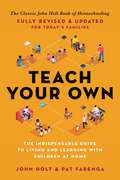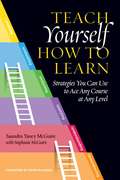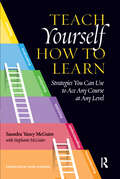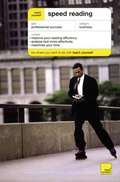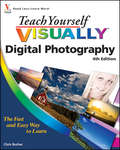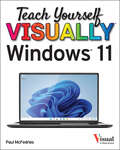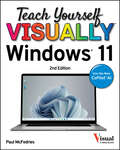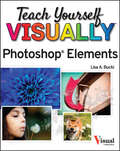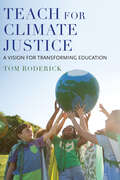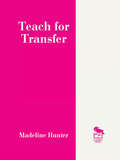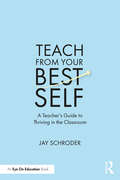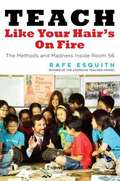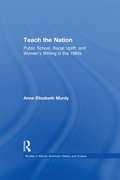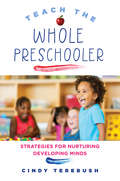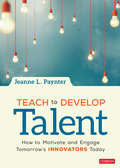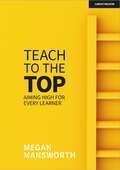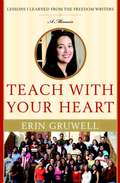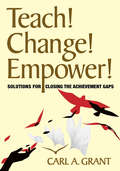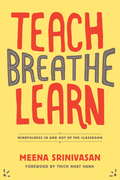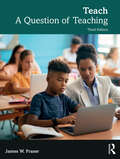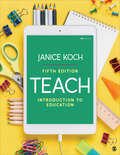- Table View
- List View
Teach Your Own: The Indispensable Guide to Living and Learning with Children at Home
by John Holt Pat FarengaThe classic guide to teaching children at home for a new generation of homeschooling parents In 2019, there were more than two million children being homeschooled. That number doubled during the pandemic and is now likely to continue increasing as more parents worry that school might not be the best place for their children to learn and grow. Teach Your Own helped launch the homeschooling movement; now, its timeless and revolutionary message of recognizing the ways children come to understand the world has been updated for today&’s environment. Parents and caregivers will discover how to navigate: Learning in a classroom versus learning in the worldThe difference between a learning difficulty (which we all experience every time we try to learn anything) and a learning disability.Schedules that achieve the homeschooling-work-life balance that you want as a familyThe relationship between learning and playHomeschooling and technologyAnd much more. John Holt's warm understanding of children and his passionate belief in every child's ability to learn have made this book an essential resource for over forty years to homeschooling families.
Teach Yourself Digital Home Movie Making
by Peter Cope'Digital' is a term that is bandied around often by marketeers who see it as a synonym for 'cutting edge' and it now appears in almost every walk of life: digital radio, digital phones, digital cameras. Digital, in its most common, if clinical, meaning describes the way in which real world information -- such as sound, colour and light -- are converted into numeric form. When we talk about digital video the key distinguishing feature is its quality. A digital video signal -- such as that produced by a sensor in a digital camera -- doesn't suffer degradation in the same way as an analogue signal. A single frame of video will be more sharply defined than that from an equivalent analogue camera. Digital video really comes into its own when we start thinking about editing. The book teaches you everything related to Digital Home Movie Making.
Teach Yourself Film Making
by Tom HoldenA straightforward guide for people who have been trying to make films, with all the techniques to succeed.
Teach Yourself How to Learn: Strategies You Can Use to Ace Any Course at Any Level
by Saundra Yancy McGuire Stephanie McGuire Mark McDaniel<p>Following up on her acclaimed Teach Students How to Learn, that describes teaching strategies to facilitate dramatic improvements in student learning and success, Saundra McGuire here presents these "secrets" direct to students. <p>Her message is that "Any student can use simple, straightforward strategies to start making A's in their courses and enjoy a lifetime of deep, effective learning." <p>Beginning with explaining how expectations about learning, and the study efforts required, differ between college and secondary school, the author introduces her readers, through the concept of metacognition, to the importance and powerful consequences of understanding themselves as learners. This framework and the recommended strategies that support it are useful for anyone moving on to a more advanced stage of education, so this book also has an intended audience of students preparing to go to high school, graduate school, or professional school. <p>In a conversational tone, and liberally illustrated by anecdotes of past students, the author combines introducing readers to concepts like Bloom's Taxonomy (to illuminate the difference between studying and learning), fixed and growth mindsets, as well as to what brain science has to tell us about rest, nutrition and exercise, together with such highly specific learning strategies as how to read a textbook, manage their time and take tests. <p>With engaging exercises and thought-provoking reflections, this book is an ideal motivational and practical text for study skills and first year experience courses.</p>
Teach Yourself How to Learn: Strategies You Can Use to Ace Any Course at Any Level
by Saundra Yancy McGuireFollowing up on her acclaimed Teach Students How to Learn, that describes teaching strategies to facilitate dramatic improvements in student learning and success, Saundra McGuire here presents these "secrets" direct to students. Her message is that "Any student can use simple, straightforward strategies to start making A’s in their courses and enjoy a lifetime of deep, effective learning." Beginning with explaining how expectations about learning, and the study efforts required, differ between college and secondary school, the author introduces her readers, through the concept of metacognition, to the importance and powerful consequences of understanding themselves as learners. This framework and the recommended strategies that support it are useful for anyone moving on to a more advanced stage of education, so this book also has an intended audience of students preparing to go to high school, graduate school, or professional school. In a conversational tone, and liberally illustrated by anecdotes of past students, the author combines introducing readers to concepts like Bloom’s Taxonomy (to illuminate the difference between studying and learning), fixed and growth mindsets, as well as to what brain science has to tell us about rest, nutrition and exercise, together with such highly specific learning strategies as how to read a textbook, manage their time and take tests. With engaging exercises and thought-provoking reflections, this book is an ideal motivational and practical text for study skills and first year experience courses.
Teach Yourself Speed Reading
by Tina KonstantSpeed-reading is about reading--and being able to recall--more written information in less time. Following a unique five-step system, this practical guide teaches readers the basics of speed-reading in less than an hour. It includes tools and information on a variety of reading and memory techniques that allow readers to start using and practicing the techniques as they read--and therefore finish this book in a fraction of the time they would have taken previously. The book shows how to read effectively under pressure and concentrate in today's noisy, distracting environments.
Teach Yourself VISUALLY Digital Photography
by Chris BucherAll-new update to this complete photography guide-over 125 photography tasks explained!Teach Yourself VISUALLY Digital Photography, Fourth Edition is a brand new take by a brand new author and professional photographer, who packs this book with heaps of essential tasks and new photos. Step-by-step screen shots show you best practices for completing more than 125 digital photography activities, including composing and lighting pictures; mixing and matching focus and lens settings; cropping, resizing, and sharpening photos; and enhancing photos with software. You'll find great tips and tricks for capturing your best photos and turning them into impressive prints and photo-based projects.As digital photography technology and photo-editing software evolve, so do the latest digital photography techniquesExplores essential digital photography concepts, including composition, lighting, focus, sharpening, and enhancing photos with photo-editing softwareDemonstrates through step-by-step instructions and numerous, full-color screen shots and photos, so you can see exactly how to perform tasksOffers tips and tricks to help you make the best captures and turn them into impressive prints and photo-based projectsSee how to produce your best digital photographs ever with this easy-to-follow visual guide!
Teach Yourself VISUALLY Windows 11 (Teach Yourself VISUALLY (Tech))
by Paul McFedriesEverything you need to know about Windows 11 in a single, visual book Teach Yourself VISUALLY Windows 11 collects all the resources you need to master the day-to-day use of Microsoft’s new operating system and delivers them in a single resource. Fully illustrated, step-by-step instructions are combined with crystal-clear screenshots to walk you through the basic and advanced functions of Windows 11. Teach Yourself VISUALLY Windows 11 offers the best visual learning techniques with comprehensive source material about the interface and substance of Windows 11, as well as: Stepwise guidance on working with files, digital pictures, and media Instructions for customizing Windows 11 and sharing your computer with family members Tutorials on installing and repairing applications, system maintenance, and computer security The fastest, easiest way for visual learners to get a grip on Windows 11, Teach Yourself VISUALLY Windows 11 is the best way to go from newbie to expert in no time at all.
Teach Yourself VISUALLY Windows 11 (Teach Yourself VISUALLY (Tech))
by Paul McFedriesA fully illustrated, up-to-date, and start-to-finish guide to using Windows 11 devices Tired of tech books that tell you what to do but never actually show you how to use your latest devices? Then Teach Yourself VISUALLY Windows 11, 2nd Edition is for you. This book walks you through exactly how to get things done in Microsoft's newest Windows updates with crystal-clear, high-resolution screenshots and pictures that won't leave you scratching your head and wondering, “Why didn't that work?” Teach Yourself Visually Windows 11 is a complete, start-to-finish visual tour of Windows 11. It will take you from “What do I do first?” to Windows guru, one picture and instruction at a time. Looking for help on how to set up your Windows 11 tablet, laptop, or desktop computer for the first time? Teach Yourself Visually Windows 11 has got you covered with the visual interface explanations, Wi-Fi connection assistance, and Microsoft account setup directions you need to make that PC come alive. And that's just chapter one. Teach Yourself VISUALLY Windows 11 will also guide you through how to customize your PC, get connected to—and stay safe on—the web, message and email your friends and family, find specific files on your hard drive, check the weather forecast, secure your device against hackers and looky-loos, and pretty much everything else you can think of. You'll find: Hundreds of hi-res, full-page images and screenshots that demonstrate basic and advanced Windows 11 tasks you'll use every day Techniques for making your PC easier to use, including changing the font size, using your voice to active your computer, and more Ways to share your photos, videos, voice notes, and messages with your loved ones See Microsoft's new Copilot AI in action and use generated text and images in your documents, emails, and chats Teach Yourself VISUALLY Windows 11 is the easiest, most intuitive, most fun, and most effective guide for everyone who prefers “show” over “tell” and who's ready to master their Windows 11 tablet, laptop, or desktop PC.
Teach Yourself Visually Photoshop Elements 2023 (Teach Yourself VISUALLY (Tech))
by Lisa A. BuckiA fast and easy way for visual learners to get a grip on Photoshop Elements Are you a visual learner? Do you prefer a single, crystal-clear screenshot showing you how to do something to a long-winded explanation telling you how to do it? If so, then this book is for you. Open up Teach Yourself VISUALLY Photoshop Elements and you’ll find vibrant, step-by-step screenshots showing you how to master over 100 Photoshop Elements tasks. Each task-based spread covers one technique at a time, ensuring you get up and running fast. You’ll learn how to: Organize, import, save, and print your photos Enhance the lighting and color of pictures that need a little sprucing up Apply cool effects that make your photos more lively and interestingThe book breaks big topics down into bite-sized modules with succinct explanations, walking you through every step you need to take. The full-color screenshots demonstrate each task, and helpful sidebars offer practical, hands-on tips and tricks you’ll use every time you open Photoshop Elements. Grab a copy today!
Teach for Climate Justice: A Vision for Transforming Education
by Tom RoderickA proactive, inclusive plan for the cross-disciplinary teaching of climate change from preschool to high school. In Teach for Climate Justice, accomplished educator and social and emotional learning expert Tom Roderick proposes a visionary interdisciplinary and intersectional approach to PreK–12 climate education. He argues that meaningful instruction on this urgent issue of our time must focus on climate justice—the convergence of climate change and social justice—in a way that is emotionally safe, developmentally appropriate, and ultimately empowering. Drawing on examples of real-life educators teaching climate change, Roderick identifies eight key dimensions of climate education that will prepare students to face the challenges of the climate crisis and give them the means to take action. These dimensions include not only educating for a deep understanding of the scientific, geopolitical, and socioeconomic equity issues that surround global warming, but also cultivating appreciation for the environment, building a supportive community, and fostering active hope for the future. Roderick's intentional layering of skills will help students develop the knowledge and sense of agency necessary to engage in civil resistance and nonviolent activism. In support of this crucial endeavor, Roderick suggests evidence-based teaching strategies, practices that promote inclusivity, and tools for social and emotional learning. This timely and uplifting book lays out a powerful vision for teaching, learning, and curriculum development to nurture a generation of courageous, informed advocates for climate justice.
Teach for Transfer
by Madeline HunterThis study of 'transfer' addresses the perplexing question: How can students possess knowledge and skills in one set of circumstances and yet not be able to apply those same skills to other situations that require them? Madeline Hunter introduces four factors designed to aid the process of transfer and promote creativity and problem-solving techniques among students: similarity, association, degree of original learning, and critical attributes.
Teach from Your Best Self: A Teacher’s Guide to Thriving in the Classroom
by Jay SchroderTeachers, this book is a guide for taking care of education’s most valuable resource: you. Author Jay Schroder, founder of the popular Teach from Your Best Self Institute, demonstrates why the version of ourselves that we bring to teaching matters and describes how we can rejuvenate ourselves while maximizing student learning. Part I explains why the self that a teacher brings to the classroom is important. Part II explores skills that will help us sustain a best-self state in all manner of situations. Part III delves into those moments when we’re provoked beyond our limits and our "hurtspots" come sharply into view. It offers ways to avert a reactive state or recover from it. Lastly, Part IV provides simple approaches for building a more durable, best self for the long term—a best self with deepened capacity to respond rather than react in the pressurized conditions of teaching. With fresh ideas presented throughout, you’ll learn how to prioritize your own well-being so you can continue to make a difference for your students.
Teach like Your Hair's on Fire: The Methods and Madness Inside Room 56
by Rafe EsquithThis book is an inspiring guide to transforming every child's education. In a Los Angeles neighborhood plagued by guns, gangs, and drugs, there is an exceptional classroom known as Room 56.
Teach the Nation: Pedagogies of Racial Uplift in U.S. Women's Writing of the 1890s (Studies in African American History and Culture)
by Anne-Elizabeth MurdyIs knowledge power? In Teach the Nation , Anne-Elizabeth Murdy explores the history and contradictions in the notion that education and literacy are vital means for improving social and political status in the US. By closely examining the rapidly shifting social context of education, and the emerging literature by and for African-American women during the 1890s, Murdy proves that the histories of education and literature are deeply connected and argues that their current lives must be regarded as mutually dependent. Teach the Nation offers a new understanding of literacy and pedagogical study and identifies how literary history enhances current feminist and anti-racist teachings. By excavating notions about education in the 1890s-as turbulent a time for American public education as today-Murdy asks readers to step back from this historical moment to better understand the contexts and institutions within which we theorize learning and teaching. In doing so, she compels readers to reimagine the potential for gaining social power through education and literature.
Teach the Whole Preschooler: Strategies for Nurturing Developing Minds
by Cindy TerebushThe world today’s children live in is much different than the world we knew at their age. That’s obvious. Yet some of our approaches with young children haven’t changed. All of us—and especially our young children—must have appropriate expectations in order to succeed. All of us, children and adults, learn more when we find the task to be enjoyable, challenging and yet achievable. Teach the Whole Preschooler will guide teachers through reconsidering your routines, your approaches, your actions, and reactions. It considers the whole child—students not only as vessels for information but as emotional human beings with newly emerging socialization skills and cognitive abilities who need to figure out their world. You will learn how to approach learning experiences with thoughtful consideration and you’ll find strategies for updating your interactions and lessons. Chapters in the book cover everything from socialization and behavioral expectations to emotional capacity and assessing reading and writing readiness. Teachers will learn how to have realistic expectations of themselves as well as their young students while preparing them for the years ahead. Readers will be encouraged to think about these questions: • Why am I doing the activities that I do and are they meaningful? • Am I doing everything possible to form a positive foundation for the students? • Do I need to let the ideas from the past go in order to make room for new approaches? Terebush ends each chapter with discussion points for your communication with parents—a vital part of teaching and something that is often overlooked. Acknowledging that there isn’t a quick fix, this book will guide readers to lead classrooms that intentionally promote a love of learning, positive self-image, and pro-social behavior that values the perceptions, thoughts and emotions of our youngest students. Through humor and relatable stories, Teach the Whole Preschooler provides new ideas, helpful hints, and strategies for a more effective experience for teachers, students, and parents.
Teach to Develop Talent: How to Motivate and Engage Tomorrow′s Innovators Today
by Jeanne L. PaynterNurture the talents of all learners Are you cultivating the real-world creative problem-solving skills today’s diverse learners need for future success? Or have we leaned so far into test preparation that we’ve left no room for developing our students’ unique talents, leaving them disengaged and unmotivated? With the new brain-based Talent-Targeted Teaching and Learning model described in this book, you can focus instead on developing all students’ metacognitive, creative problem-solving, and leadership skills alongside the required content standards. Teach to Develop Talent applies the psychology of motivation, engagement, and achievement to practical, culturally responsive strategies educators can use to equitably identify and develop students’ cognitive and social-emotional skills, including curiosity, creativity, perseverance, reasoning, persistence, empathy, and more. With this book, you can: Identify and develop all learners’ aptitudes for innovation in STEM and humanities Transform any curriculum or standards into long-term aims for talent development Support and assess student progress with dozens of customizable checklists, templates, rubrics, and surveys Challenge and engage all learners, especially diverse gifted students Ideal for implementation in virtual or traditional learning environments, you will ensure your students’ long-range and multi-faceted success with this hands-on guide.
Teach to Develop Talent: How to Motivate and Engage Tomorrow′s Innovators Today
by Jeanne L. PaynterNurture the talents of all learners Are you cultivating the real-world creative problem-solving skills today’s diverse learners need for future success? Or have we leaned so far into test preparation that we’ve left no room for developing our students’ unique talents, leaving them disengaged and unmotivated? With the new brain-based Talent-Targeted Teaching and Learning model described in this book, you can focus instead on developing all students’ metacognitive, creative problem-solving, and leadership skills alongside the required content standards. Teach to Develop Talent applies the psychology of motivation, engagement, and achievement to practical, culturally responsive strategies educators can use to equitably identify and develop students’ cognitive and social-emotional skills, including curiosity, creativity, perseverance, reasoning, persistence, empathy, and more. With this book, you can: Identify and develop all learners’ aptitudes for innovation in STEM and humanities Transform any curriculum or standards into long-term aims for talent development Support and assess student progress with dozens of customizable checklists, templates, rubrics, and surveys Challenge and engage all learners, especially diverse gifted students Ideal for implementation in virtual or traditional learning environments, you will ensure your students’ long-range and multi-faceted success with this hands-on guide.
Teach to the Top: Aiming High for Every Learner
by Megan MansworthTeach to the Top is a research-informed guide to aspirational teaching, focusing on how embedding higher-level knowledge in the classroom empowers students to succeed and to enjoy learning. Questioning existing orthodoxies around ability, Teach to the Top sets out a vision for an education system in which pupils of all attainment levels are enabled to make fantastic progress by being exposed to sophisticated concepts, and afforded opportunities to think deeply and grapple with stimulating ideas. Making a convincing case for the centrality of subject knowledge, the book also shows how affording teachers the professional autonomy to participate in continual development of their own knowledge benefits both teachers and students. As well as engaging critically with a wealth of educational research, Teach to the Top outlines a plethora of research-informed strategies for teaching to the top. Topics include embedding advanced knowledge in curriculum planning, approaches to challenging classroom talk, the fundamental importance of increasing learners’ confidence, the dangers of differentiation and grade-focused feedback, and the value of an adaptable approach to planning. Both thoughtful and practical, Teach to the Top develops a persuasive justification for the entitlement of every child to higher-level knowledge, alongside providing teachers with a range of practical suggestions and questions for reflection to enable the application of this philosophy to their own classrooms.
Teach to the Top: Aiming High for Every Learner
by Megan MansworthTeach to the Top is a research-informed guide to aspirational teaching, focusing on how embedding higher-level knowledge in the classroom empowers students to succeed and to enjoy learning. Questioning existing orthodoxies around ability, Teach to the Top sets out a vision for an education system in which pupils of all attainment levels are enabled to make fantastic progress by being exposed to sophisticated concepts, and afforded opportunities to think deeply and grapple with stimulating ideas. Making a convincing case for the centrality of subject knowledge, the book also shows how affording teachers the professional autonomy to participate in continual development of their own knowledge benefits both teachers and students. As well as engaging critically with a wealth of educational research, Teach to the Top outlines a plethora of research-informed strategies for teaching to the top. Topics include embedding advanced knowledge in curriculum planning, approaches to challenging classroom talk, the fundamental importance of increasing learners’ confidence, the dangers of differentiation and grade-focused feedback, and the value of an adaptable approach to planning. Both thoughtful and practical, Teach to the Top develops a persuasive justification for the entitlement of every child to higher-level knowledge, alongside providing teachers with a range of practical suggestions and questions for reflection to enable the application of this philosophy to their own classrooms.
Teach with Your Heart: Lessons I Learned from the Freedom Writers
by Erin GruwellIn this memoir and call to arms, Erin Gruwell, the dynamic young teacher who nurtured a remarkable group of high school students from Long Beach, California, who called themselves the Freedom Writers, picks up where The Freedom Writers Diary(and the movie The Freedom Writers) end and catches the reader up to where they are today. Teach with Your Heart will include the Freedom Writers' unforgettable trip to Auschwitz, where they met with Holocaust survivors.
Teach! Change! Empower!: Solutions for Closing the Achievement Gaps
by Carl A. Grant"Teach! Change! Empower! takes the concepts of diversity and change—which are often complex, abstract, confusing, and not salient to many teachers who struggle with the meaning of these concepts in actual classroom practices—and uses them as a framework for something that is very real to teachers: the achievement gap."—Barbara Heuberger Rose, Associate ProfessorMiami University"Readers are challenged to think about themselves and their role in addressing achievement gaps in a non-blaming manner. Carl Grant does an outstanding job of incorporating the work of a number of researchers."—Maria Whittemore, Minority Achievement CoordinatorFrederick County Public Schools, MDNarrow the achievement gap by affirming diversity and engaging in a process of personal change!The achievement gap illustrates restricted life chances and choices for many students, and only by addressing these inequities can we enable all learners to reach their fullest potential. Teach! Change! Empower! provides a powerful, step-by-step process for making the changes necessary to close the achievement gaps in your school!This innovative resource offers a wealth of strategies and action plans to help teachers reflect on their own beliefs about diversity and power and turn those reflections into actions. Educators can put into practice ideas that challenge the status quo, including:Culturally relevant curriculum and environments for studentsCaring with a social-political consciousness within a culture of learningCooperative professional development for teachers, administrators, and staffDemocratic student involvementInitiate change in your classroom that fosters lifelong learning in yourself, your students, and your school!
Teach, Breathe, Learn: Mindfulness in and out of the Classroom
by Meena SrinivasanIn Teach, Breathe, Learn, Meena Srinivasan highlights how mindfulness can be an effective tool in the classroom. What makes this book truly unique is her perspective as a classroom teacher, wrestling daily with the conditions about which she writes. <P> <P> "Teach, Breathe, Learn provides accessible, practical application of mindfulness to overcome challenges faced during the school day." Testimonials from students and colleagues are woven throughout the book. Teach, Breathe, Learn is designed for educators at all levels, parents interested in sharing mindfulness with their children, and anyone curious about how to cultivate their own mindfulness practice and eventually teach mindfulness to others.Part 1 helps teachers develop compassion and shift from "reacting" to "responding" to demands.Part 2 offers techniques for cultivating loving-kindness, gratitude and seeing students, colleagues, and parents as oneself.The last section of the book introduces a curriculum teachers can use to incorporate mindfulness into their classroom, replete with lesson plans, handouts, and homework assignments.
Teach: A Question of Teaching
by James W. FraserIs teaching for me? Who will I teach? How can I make a difference? Teach is a vibrant and engaging Introduction to Education textbook, organized around real questions students ask themselves and their professors as they consider a career in teaching. Using vivid and contemporary examples, veteran teacher educator James W. Fraser continually encourages readers to reflect on their experiences and engage in a dialogue about the most current issues in education. The thoroughly updated third edition includes fully rewritten chapters, including one discussing the current debates about classroom discussions of race and sexuality and the impact of the COVID-19 pandemic on schools and another on today’s newest technologies and their impact on teachers and schools. In each chapter, newly selected primary source readings provide students with the latest in education-related scholarship and integrates the intellectual foundations of education throughout each chapter, offering scholarly and current content in a student-friendly format. Features and updates include: • In a new, thoroughly revised and up-to-date but also much more compact version, the third edition of the popular Teach textbook for basic courses in a teacher education program invites aspiring teachers and the simply curious to ponder many of the most essential questions of what a career in teaching might look like in the next decades of the 21st century. • Up-to-date coverage of new legislation and school policies that impact teachers including debates about discussions on race and Critical Race Theory, sexuality and the importance of LGBTQ+ history and current rights that influence curricula, school policies, and teachers' free-speech rights, with particular emphasis on the declining role of the Common Core State Standards. • A completely rewritten Chapter 8 offers an up-to-the-minute overview of how technology can help improve and challenge teachers and teaching. • Features such as “Teachable Moment” and “Notes from the Field” encourage readers—through a variety of prompts and exercises—to reflect on their own educational experiences and goals, and challenge prospective teachers to imagine themselves in similar situations. • Short chapters and digestible sections provide an approach and format to reach students without compromising on high-quality content. • The concluding chapter explores the question, “Where do I go from here?” to help prospective teachers develop a plan for their career and design a personal philosophy to guide them. Teach presents an overview of the field in a way sure to keep students reading and gives those with questions about teaching the tools and information they need to continue a rich dialogue about their possible careers.
Teach: Introduction to Education
by Janice KochThe fifth edition of the best-selling Teach by Janice Koch aims to help students answer the question, "Is teaching the right career for me?" Via a concise but wide-ranging exploration of the American public education system, Teach asks readers to imagine themselves in the classroom and develop their own ideas of what it means to be a teacher. Real-life classroom stories from teachers themselves help readers see themselves as teachers. Chapters feature the latest edTPA and InTasc Standards to structure learning, as well as learning outcomes and journal prompts to give readers clear goals and ways to build their teaching skills. This new edition features major emerging issues in education, including developments in technology in the classroom, with both positive and negative implications; more on the STEM, STEAM, and maker movements; school choice and homeschooling; sexual orientation and gender identity; diversity, equity, and inclusion; and the importance of personal wellness in teacher success. Throughout the text, the author references and contextualizes the effects of the COVID-19 pandemic, where appropriate, to reflect the ways students, teachers, and classrooms have been altered by this historic event. Combining historical and contemporary perspectives, this text helps future teachers examine the ways in which society and culture shape schools and the ways in which schools shape society and culture.
